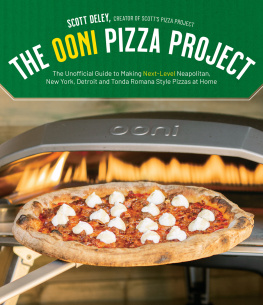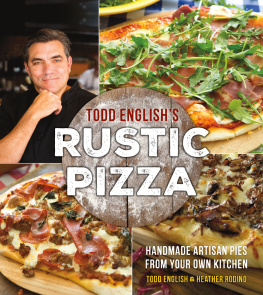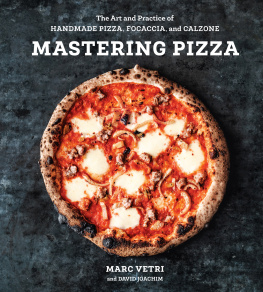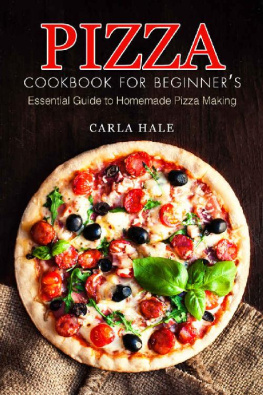ACKNOWLEDGMENTS
Three short months after opening Trifecta Tavern, I was crazy enough to decide to write this book. There is no way I could have completed this project without the excellent workevery dayof my staff at Trifecta, Kens Artisan Bakery, and Kens Artisan Pizza, where pride of place and product drive my talented teams. A very heartfelt thank-you to you all.
The greatest joy for me came from the people who welcomed me into their worldswho generously taught me about their approach to pizza, their tomatoes, their water buffalo cheese, or their flour. A special thank-you to Fred Mortati of Orlando Foods and John Magazino of Chefs Warehouse, for making the introductions to producers in Italy and opening doors to the land of Campania, where I found the true soul of pizza. Likewise, heartfelt thanks go out to Costantino Cutolo of Compagnia Mercantile DOltremare, Bernardino De Vita of Agricola Casearia Lupara, and Mauro and Antimo Caputo of Antico Molino Caputo in Naples.
Two of Italys greatest pizzaiolos, Enzo Coccia and Franco Pepe, gave me a strong sense of pizzas place in Campania; they have devoted their lives to advancing the craft that is not only theirs, but also their fathers and their grandfathers professione . The pride, professionalism, artistry, and just plain magnificence of their pizzas touched me deeply.
Alan Weiner took so many great photos for this book that we were greatly challenged deciding what to place and which shots needed a separate gallery of their own. A giant thanks to Alan, a photojournalist extraordinaire.
First level editing and recipe testing from Kat Merck was indispensable.
Finally, a very special thanks to the team at Ten Speed Press. I am very proud to be one of your authors. Designer Kara Plikaitis put text and photos into a beautifully designed book, and copyeditor Clancy Drake kept my words on the straight and true. Most of all, senior editor Emily Timberlake has the magic to inspire and guide, encourage, and even laugh at my marginal jokes.
Much love to all. Especially Gomez, who never has a bad day.
MEASUREMENT CONVERSION CHARTS
VOLUME
Formulas
1 teaspoon = 4.93 milliliters
1 tablespoon = 14.79 milliliters/3 teaspoons
1 cup = 236.59 milliliters/16 tablespoons
1 liter = 202.88 teaspoons/67.63 tablespoons/4.23 cups
| U.S. | IMPERIAL | METRIC |
| 1 tablespoon | fl oz | 15 ml |
| 2 tablespoons | 1 fl oz | 30 ml |
| cup | 2 fl oz | 60 ml |
| cup | 3 fl oz | 90 ml |
| cup | 4 fl oz | 120 ml |
| cup | 5 fl oz ( pint) | 150 ml |
| cup | 6 fl oz | 180 ml |
| 1 cup | 8 fl oz ( pint) | 240 ml |
| 1 cups | 10 fl oz ( pint) | 300 ml |
| 2 cups (1 pint) | 16 fl oz ( pint) | 480 ml |
| 2 cups | 20 fl oz (1 pint) | 600 ml |
| 1 quart | 32 fl oz (1 pints) | 1 l |
WEIGHT
Formulas
1 ounce = 28.35 grams
1 pound = 453.59 grams/16 ounces
1 kilogram = 2.2 pounds
| U.S./IMPERIAL | METRIC |
| oz | 15 g |
| 1 oz | 30 g |
| 2 oz | 60 g |
| lb | 115 g |
| lb | 150 g |
| lb | 225 g |
| lb | 350 g |
| 1 lb | 450 g |
LENGTH
Formulas
1 inch = 2.54 cm
1 foot = 0.3 m/12 inches
1 cm = 0.39 inch
1 m = 3.28 feet/39.37 inches
| INCH | METRIC |
| inch | 6 mm |
| inch | 1.25 cm |
| inch | 2 cm |
| 1 inch | 2.5 cm |
| 6 inches ( foot) | 15 cm |
| 12 inches (1 foot) | 30 cm |
TEMPERATURE
Formulas
9/ C + 32 = F
(F 32) 5/ = C
| FAHRENHEIT | CELSIUS/GAS MARK |
| 250F | 120C/gas mark |
| 275F | 135C/gas mark 1 |
| 300F | 150C/gas mark 2 |
| 325F | 160C/gas mark 3 |
| 350F | 175 or 180C/gas mark 4 |
| 375F | 190C/gas mark 5 |
| 400F | 200C/gas mark 6 |
| 425F | 220C/gas mark 7 |
| 450F | 230C/gas mark 8 |
| 475F | 245C/gas mark 9 |
| 500F | 260C |
CHAPTER 1
THE SOUL OF PIZZA
In 2014, a trip to Italy changed my thinking about pizza forever. I was moved by the way the people I met in Naples relate to pizza: for them, it was a soulful connection, related to the bigger picture of who they are as a culture. And then I became interested in the stories of the immigrants from Naples and the south of Italy who began making pizza in the United States in the early 1900s. I wanted to learn how pizza evolved from its early days to the present, how it stayed true to its roots in Italy, and how it grew to be its own thing in America. The stories always came back to the pizza maker, and how his or her passion was as important as the quality of the tomatoes.
ITALY
Enzo Coccia, a globally celebrated Neapolitan pizzaiolo , altered my pizza reality when he made me stare at a naked truth I had not confronted directly before. Pizza is not the same as bread, he said, and Im glad he said it with force. Meaning I needed to adjust my thinking.
I set out to understand pizzas place in the culture, which means understanding its history and the role it plays in peoples lives, and meeting the people making it today. During my visit, I focused on Naples and Rome. Naples, because it is where pizza began. Neapolitans bleed pizzait is a defining element of who Neapolitans are and how they live. Rome, because it has two distinct styles of pizza that I admire: one a super-thin crusted wood-fired-oven style; the other called al taglio , served by the slice, which is found in bakeries. You will find pizza in both of these cities styles, with plenty of hybrids of the two, throughout Italy and beyond. In Bologna you will find very thin crust pizza like in Rome, but as a much larger pie, and in Florence its possible to find crust even thinner than in Bologna. In this book I focus on the styles of pizza that both interest me most and that I believe can be successfully adapted for the home kitchen. It inspires me that pizza making is not a static craft in Naples and Rome. The best pizzaiolos are pushing their skill to new heights, making extremely high-quality pizzas that are in harmony with tradition but not constrained by it. In my mind, this is the best evolution possible. Its like jazz to me.
Naples
Naples is the birthplace of pizza, where by most accounts it took its modern form in the 1700s, without tomatoeswhich, though they were first imported to southern Italy in the 1500s, probably didnt make it onto pizzas until the 1800s. Establishing firm timelines for specific evolutionary steps in pizza history (or for any other food that began as a street food) is difficult. One of the earliest Neapolitan pizzerias in the written record is Zi Ciccio, first written about in 1727, located in the Piazza Cavour. Others from that era include Portalba and, in Porta San Gennaro, the pizzeria Capasso. According to one account, the most successful was called Ntuono, run by Antonio Testa near the church of Santa Teresa, where King Ferdinand I (1751 to 1825), the ruler of Naples, secretly went to eat. Did he wear a wig? (It wasnt the public he was hiding his pizza habit from; it was his wife, Queen Maria Carolina of Austria, Marie Antoinettes sister, who apparently dominated her unsophisticated husband and ruled the Kingdom of Naples in his name.)


![Ken Forkish - Evolutions in Bread: Artisan Pan Breads and Dutch-Oven Loaves at Home [A baking book]](/uploads/posts/book/323066/thumbs/ken-forkish-evolutions-in-bread-artisan-pan.jpg)







